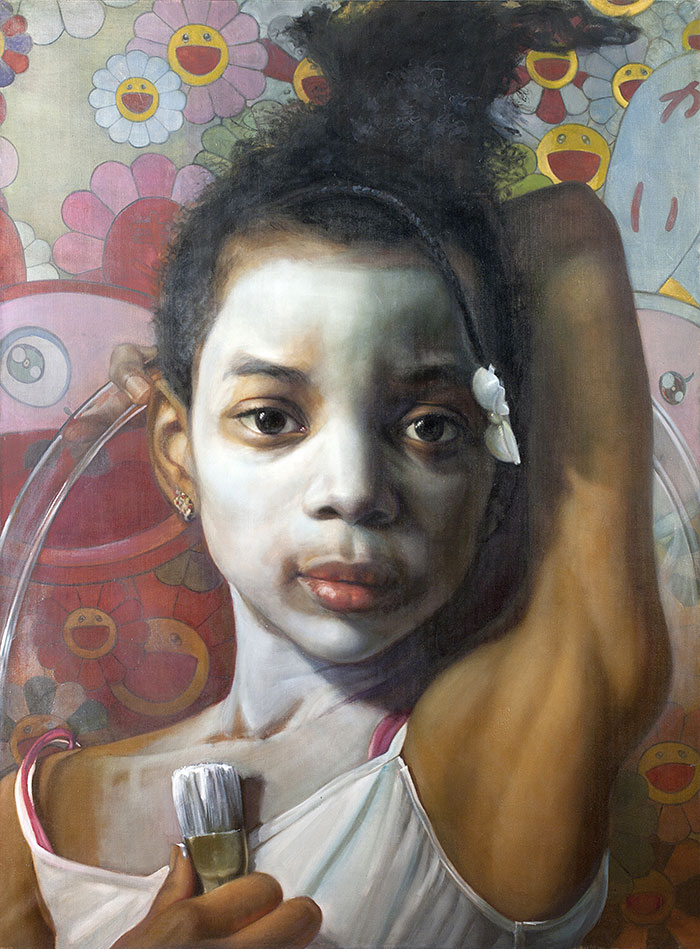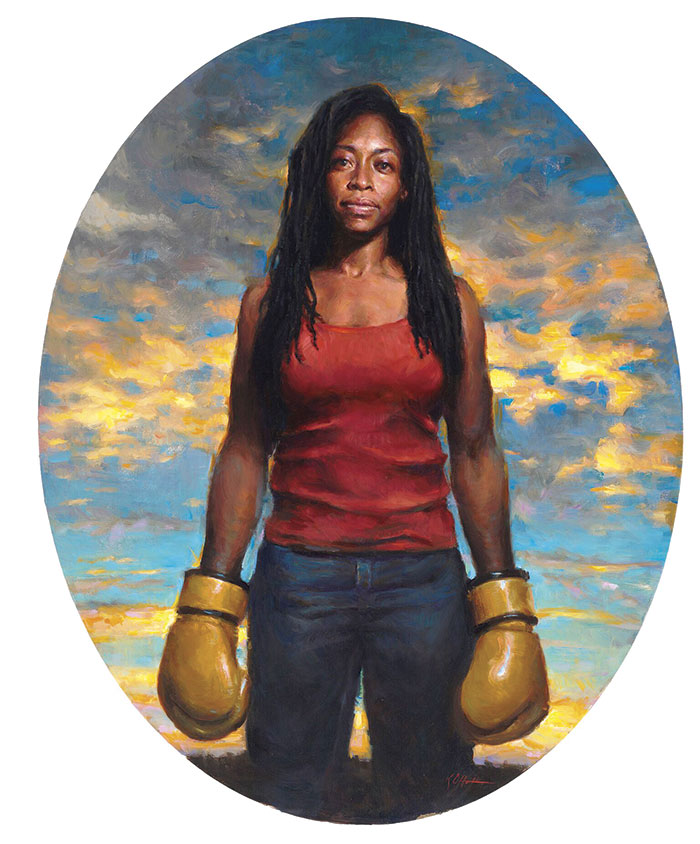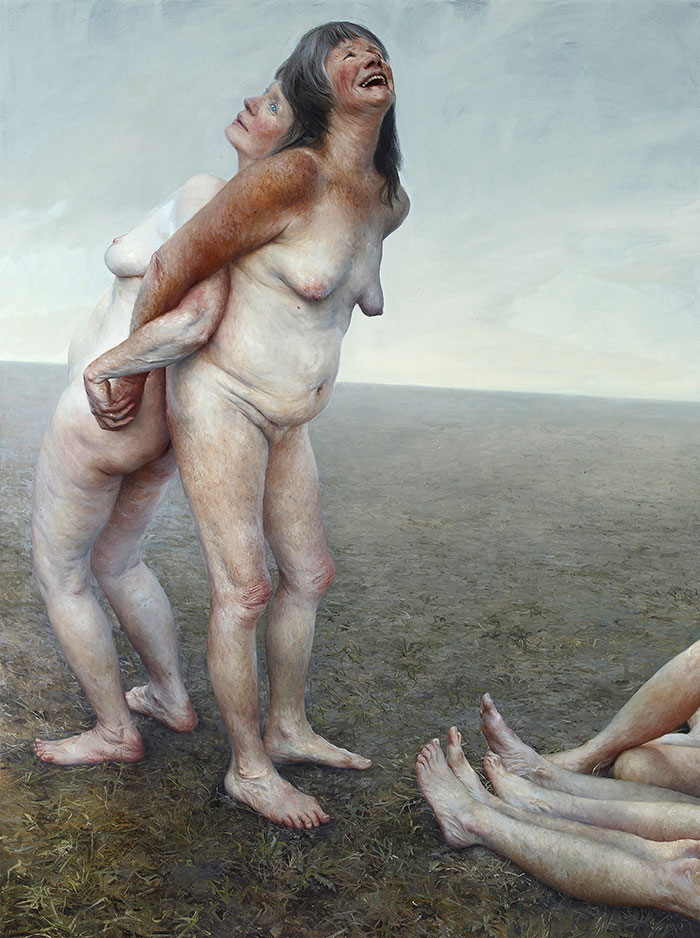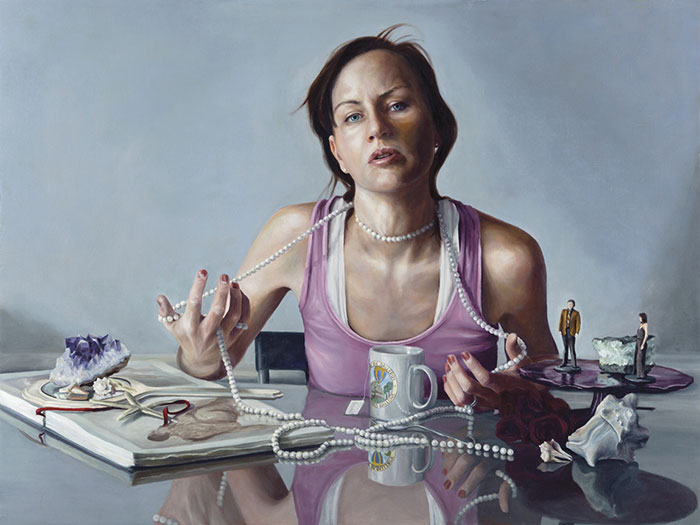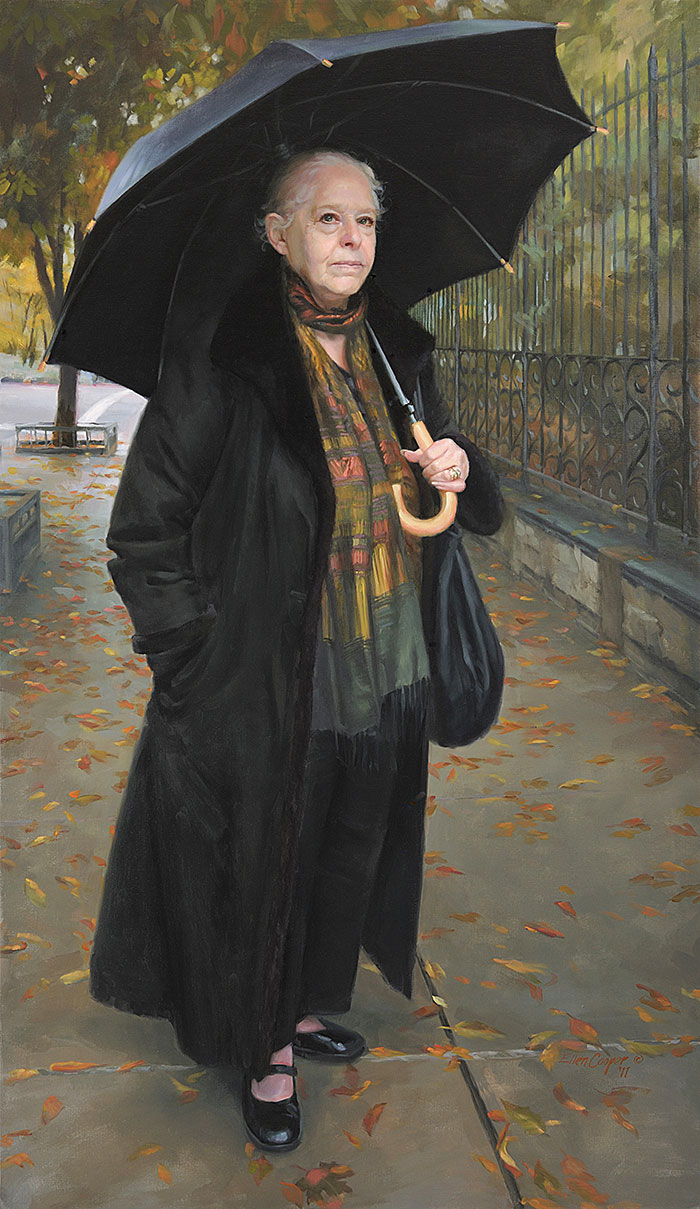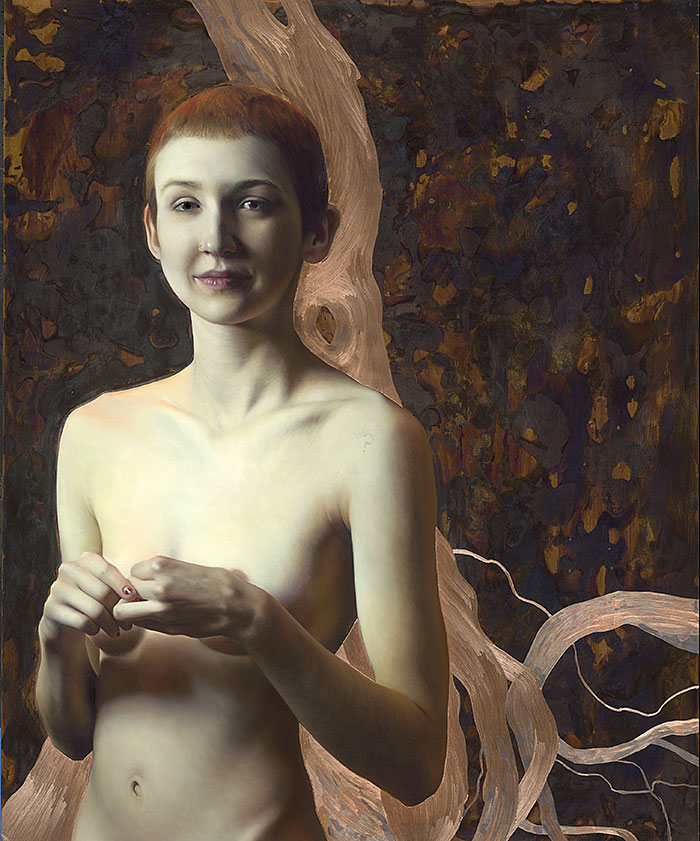| Setting the Record Straight on Women in the Arts | |||||||
| by Cynthia Close | |||||||
photos of paintings courtesy Helen Day Art Center, Stowe
The Artist, Margaret Bowland, 2010,oil on linen,74 x 54
|
|||||||
Why have there been no great women artists? Feminist art critic and historian Linda Nochlin posed that question in her groundbreaking essay of the same name, published in ArtNews in January 1971. Nochlin, who died in October 2017 at age 86, suggested that even posing this question buys into the underlying presumption that “there are no great women artists because women are incapable of greatness.” Rather, Nochlin suggests, it’s a “miracle … that given the overwhelming odds against women, or blacks, that so many of both have managed to achieve so much sheer excellence, in those bailiwicks of white masculine prerogative like science, politics, or the arts.” We must first, she writes, examine our institutional and social structures and the view of reality they impose on us. Although women through the centuries have always made art, they were mainly recognized for their efforts in the so-called domestic arts of lacemaking, quilting, sewing, and pottery, rather than the fine arts of painting and sculpture. In the male-dominated fine arts, women primarily functioned as muses, posing nude for male artists. A few female late Renaissance artists—like Artemisia Gentileschi (1593–1656), whose work rivaled that of Caravaggio, and Mary Beale (1633–1699), one of the most talented portrait painters of her time—earned the right to place their easels side by side with their male counterparts. But these women usually had the benefit of upper-class wealth and the support of their fathers or, in the case of Mary Beale, their husbands. And despite their obvious talent, the entrenched system of arts education, art criticism, art patronage, and art history sabotaged their rightful place in the pantheon of greatness reserved for their male counterparts. H. W. Janson’s textbook History of Art, first published in 1962, the year before I entered Boston University as an art major, was the primary reference book used in art history classes. Because of my own naiveté and acceptance of the status quo, I did not question, as an art student, the glaring omission in the text—not a single female artist was considered worthy of inclusion, a stunning example of the acknowledged erasure of women from art history. Janson, when confronted with the evidence that, indeed, great women artists existed, simply stated, “I do not include women painters in my books.”
It wasn’t until 1987 that women artists began appearing in the pages of this bible of art history instruction. Likely, the arrival and tenure of Janson’s son Anthony F. Janson, also a professor and museum professional, as editor, from the senior Janson’s death in 1982 until 2004, was a factor. Today, History of Art, in its eighth edition and still considered a definitive text, has three women on its editorial team: Penelope J. E. Davies, a scholar of Greek and Roman art; Frima Fox Hofrichter, author of Judith Leyster: A Dutch Artist in Holland’s Golden Age; and Ann M. Roberts, specializing in women artists of the Renaissance. Presumably, all have brought their expertise to the current edition, doing their part to continue to correct this grave injustice. The irony is that during my years as an art student earning my MFA, from 1963 to 1969, women made up the majority of students while all the professors were male, except for one part-time woman who taught perspective in the freshmen core program. This did not strike me as strange. I liked and admired my professors, all of whom treated me well, and I flourished in spite of this gender disparity. Figure drawing from the live nude model was at the heart of my traditional art school curriculum. Unlike the moral restrictions put on women artists from earlier times, who were only permitted to draw clothed figures and not allowed to work in the same life drawing classes with male artists, we female students drew nude women and men in every conceivable pose, along with the male students, guided by our male instructors. According to a recent report on gender disparity in the arts compiled by the National Museum of Women in the Arts in Washington, DC, although women still make up 60 to 75 percent of those studying art at the university level, female artists comprise no more than 30 percent of the artists shown in museums and galleries. Furthermore, though women earn half of the MFAs granted in the US, less than a quarter of solo exhibitions in New York galleries feature women. Obviously, the process of acknowledging the gender inequities in the arts has not resulted in a swift reordering of priorities. Why are there so many female art students and so few female artists exhibiting? In response, Maura Reilly, the founding curator for the Elizabeth A. Sackler Center for Feminist Art at the Brooklyn Museum states, “I’m tired of being asked the question, ‘Why is there continued inequality?’ I always think to myself, what planet are you living on? We live in a society ruled by males in every sector, not just art … If you are trying to break into a market that is already predisposed to men, 70 to 30 percent in the gallery world, for instance, your chances for success are significantly less. The entire system is stacked against you.”
The problem of women artists not exhibiting in galleries extends to museums. Venerable art institutions are slow to change. At the Metropolitan Museum of Art, less than 5 percent of artists in the modern section are women, yet 76 percent of the nudes are female. Women are also underrepresented at the top echelons of the curatorial community. Here in Vermont we seem to be bucking the trend. Our larger exhibiting institutions and many of the most respected galleries in the state are headed by women. Doreen Kraft is one of the most visible on the Vermont art scene and an influential tastemaker. She is executive director of Burlington City Arts (BCA), and she has brought many other women on to the staff of the BCA, among them Sara Katz, her assistant director, Heather Ferrell, director of exhibitions, Kate Ashman, public arts coordinator, and Mary Zompetti, photography program director. Janie Cohen, director of UVM’s Fleming Museum, has showcased the work of many women artists. Most recently, Cohen honored the graphic novelist Alison Bechdel with her first museum exhibition, and last year the American photographer Catherine Jansen actively collaborated with museum staff in an immersive multimedia presentation of her work. Around the state, women are running galleries. Anni MacKay founded BigTown Gallery in Rochester. She is the director/curator and an activist in the promotion of developing a “creative economy” where all artists play a significant role. Sophie Pickens and her partner, Justine Jackson, founded NODA (Northern Daughters gallery) in Vergennes in part to provide gallery representation for their artist-mothers. NODA has turned the usual ratio of male to female artists on its head. Of the 16 gallery artists listed on their website, 14 are women.
Rachel Moore, director and curator at the Helen Day Art Center in Stowe, understands the gender dilemma from both an artist’s and a curator’s perspective. She is simultaneously exhibiting her own multimedia work while she organizes and selects artists to exhibit at the Helen Day. As both gatekeeper and maker, she understands and empathizes with the requirements needed to serve effectively in both roles. This summer, inspired in part by the MeToo movement, she collaborated with Diane Feissel, artist and cofounder of Women Painting Women, and Vermont artist August Burns to co-curate Reclamation: Women Painting Women, an exhibition of 17 nationally acclaimed contemporary figurative women artists who primarily paint female subjects, which ran from June 15 to September 8.
Burns is an award-winning portrait painter, and while she painted the official portrait of former Vermont governor Peter Shumlin, she is widely known for her emotive portraits of women. She also openly advocates for women’s rights on social media. Feissel, along with artists Alia El-Bermani and Sadie Valeri, established, in 2009, the website Women Painting Women to provide more options for female artists. Feissel hopes to create a catalogue of the work of living female artists who paint women, most in a realist vein. The popular site has featured the work of hundreds of international women painters and inspired collaborations with cultural institutions of exhibitions of these artists’ works, like the recently closed exhibit at the Helen Day. Under the general stylistic umbrella of realism, the artists at the Reclamation exhibit demonstrated the tremendous diversity and creativity possible within that designation. Simultaneously, the overall quality of the work was impressive. All the artists have exhibition histories and accolades in their biographies as a testament reinforcing the idea that those same skills lauded in the Renaissance are still being rewarded today. While the painterly skills on display in this exhibition cannot be ignored, it was the emotional intensity of the work that reached out and grabbed me. In The Artist by Margaret Bowland (2010, 74 by 54 inches, oil on linen), a young black girl, in whiteface, stares unabashedly at the viewer, while clutching a paintbrush. Although Bowland is white, she often paints African American subjects, usually covered in white pigment. This may seem shocking. To explain, Bowland states, “When making works I have often covered my subject in paint to make this point. I feel that I am doing what the world does to my subjects, tries to obliterate them or turn them into people they are not. For me, the victory is that my people stare back at you completely whole, completely themselves. No matter the costume or the make up you are looking at an individuated and very real, human being. They have, or are learning to survive through what the world has thrown at them.”
Aleah Chapin, a 32-year-old from an island north of Seattle, Washington, paints the people in her life, friends and family, mostly naked, including her own mother. She does not shy away from the reality of aging flesh; the sagging breasts, wrinkled, sun-blotched skin drooping on once strong upper arms, graying, untamed hair, all painted with an honesty that can be painful to see. The full focus of both artist and viewer is on the body and, even more specifically, the quality of the flesh. Her figures are usually placed against blank backgrounds, such as in And We Were Birds (2013, 94 by 76 inches). In this oil painting, two older women stand naked, back to back, with arms linked, on an empty patch of land with an equally empty sky. Also visible are three sets of bare legs cut off from the bodies they belong to by the lower right edge of the canvas. The mutual trust, honesty, and vulnerability between the artist and those who offer themselves as models in these paintings are rare and not without risk. Pennsylvania artist Erin Anderson’s technique of oil painting on copper plate adds a surreal dimension to her work. In The Candidate (2017, 36 by 36 inches), a naked elfin-like woman, perhaps prepubescent, stares directly at the viewer. The hint of a smile on her lips, with her body cut off just above her pubic area and her small breasts obscured by her hands held in an awkward configuration, suggests the gawkiness of this time, between childhood and young woman. Her pale skin glows with an inner light reflected in and contrasting to the rich etched copper colored background of an abstracted tangle of roots—a stunning and, for all its realism, enigmatic portrait. The impact of the Women Painting Women movement on the greater art world is difficult to assess. The matter of setting the record straight is ongoing.
|
|||||||
|
Cynthia Close is a contributing editor for Documentary Magazine, former art editor for the literary journal Mud Season Review, and an adviser to the Vermont International Film Foundation. She lives in Burlington, Vermont.
|
||||||
